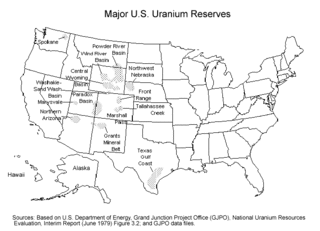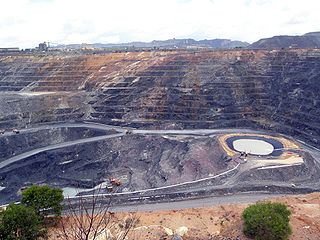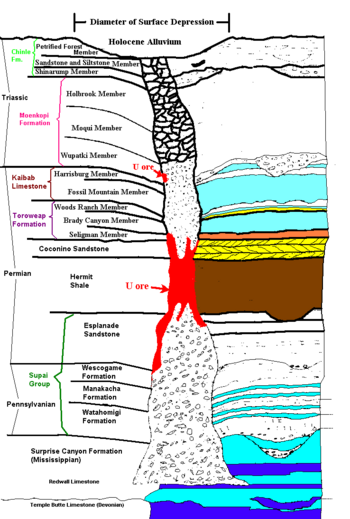History
The earliest breccia pipe mined for uranium was the Orphan, a mineralized pipe exposed on the southern wall of the Grand Canyon within the Grand Canyon National Park. During the late 70s, Energy Fuels Nuclear, Inc. (founder Bob Adams and successor Oren Benton) began a concerted effort to locate and then mine further examples of this previously neglected class of uranium deposit. With the exploration success of Energy Fuels and the ensuing development of the early Hack 1 and 2, Pigeon, and Kanab North mines, competing exploration and mining companies soon entered northern Arizona. During the 1970s and 1980s, relatively large companies such as Gulf Resources, Pathfinder Mines Corporation, Rocky Mountain Energy Company, and Uranerz all competed with Energy Fuels Nuclear, Inc., for mineral rights in the predominantly public lands of the Arizona Strip. By 1989, at least 13 uranium-ore-bearing breccia pipes had been identified by various companies. Nearly all northern Arizona uranium exploration had stopped by that year, however, due to the low uranium price.
Each of the ore-bearing breccia pipes mined during the 1980s was developed by Energy Fuels, which shipped ore northeast to its White Mesa Mill in Blanding, Utah. According to the United States Geological Survey, Energy Fuels Nuclear, Inc., produced in excess of 19 million pounds of U3O8 from seven mines through the 1980s.
The reason for uranium exploration and uranium mining in northern Arizona, during a period of low yellowcake price, was the high grade and compact nature of the uranium mineralization contained in some of the collapse breccia pipes in the region. In 1982, total production cost for breccia pipe uranium was about $10/lb U308 concentrate that then sold for approximately $40/lb. [1] Later inflation-corrected cost data published by EFN in the Canyon Mine Environmental Impact Statement confirms the 1982 total cost quotation. In 2007 US dollar terms, the total cost to produce a pound of U308 from the average pipe was about $24. Average ore reserves for an individual mineralized pipe at that time were determined to be about 3.5 million pounds U308, with an average grade of about 0.6 percent U308, then giving the average economically mineralized pipe an approximate before-tax, undiscounted in-ground value of about $105 million (more than $225 million in 2007 US dollars). The breccia pipe mineral deposits range from 1000 to 1800 feet deep and have a vertical extent of up to 600 feet. The pipes typically have a 200-to-400-foot (61 to 122 m) diameter. A 1,000-to-1,600-foot-deep (300 to 490 m) shaft is usually required to access the deposits. In some cases where a mineralized pipe occurs near a deep canyon, a decline can be used instead of a shaft to access the ore during mining.

Uranium mining is the process of extraction of uranium ore from the ground. Over 50 thousand tons of uranium were produced in 2019. Kazakhstan, Canada, and Australia were the top three uranium producers, respectively, and together account for 68% of world production. Other countries producing more than 1,000 tons per year included Namibia, Niger, Russia, Uzbekistan, the United States, and China. Nearly all of the world's mined uranium is used to power nuclear power plants. Historically uranium was also used in applications such as uranium glass or ferrouranium but those applications have declined due to the radioactivity of uranium and are nowadays mostly supplied with a plentiful cheap supply of depleted uranium which is also used in uranium ammunition. In addition to being cheaper, depleted uranium is also less radioactive due to a lower content of short-lived 234
U and 235
U than natural uranium.

National Atomic Company Kazatomprom Joint Stock Company (Kazatomprom) (Kazakh: Қазатомөнеркәсіп, romanized: Qazatomónerkásip) is the world’s largest producer and seller of natural uranium, providing over 40% of global primary uranium supply in 2019 from its operations in Kazakhstan. Kazatomprom's uranium is used for the generation of nuclear power around the world.

Uranium mining in the United States produced 173,875 pounds (78.9 tonnes) of U3O8 in 2019, 88% lower than the 2018 production of 1,447,945 pounds (656.8 tonnes) of U3O8 and the lowest US annual production since 1948. The 2019 production represents 0.3% of the anticipated uranium fuel requirements of the US's nuclear power reactors for the year.

Uranium mining in Colorado, United States, goes back to 1872, when pitchblende ore was taken from gold mines near Central City, Colorado. The Colorado uranium industry has seen booms and busts, but continues to this day. Not counting byproduct uranium from phosphate, Colorado is considered to have the third largest uranium reserves of any US state, behind Wyoming and New Mexico.

Uranium mining in Wyoming was formerly a much larger industry than it is today. Wyoming once had many operating uranium mines, and still has the largest known uranium ore reserves of any state in the U.S. At the end of 2008, the state had estimated reserves dependent on price: 539 million pounds of uranium oxide at $50 per pound, and 1,227 million pounds at $100 per pound.

Uranium mining in Utah, a state of the United States, has a history going back more than 100 years. Uranium mining started as a byproduct of vanadium mining about 1900, became a byproduct of radium mining about 1910, then back to a byproduct of vanadium when the radium price fell in the 1920s. Utah saw a uranium boom in the late 1940s and early 1950s, but uranium mining declined in the 1980s. Since 2001 there has been a revival of interest in uranium mining, as a result of higher uranium prices.

Uranium ore deposits are economically recoverable concentrations of uranium within the Earth's crust. Uranium is one of the most common elements in the Earth's crust, being 40 times more common than silver and 500 times more common than gold. It can be found almost everywhere in rock, soil, rivers, and oceans. The challenge for commercial uranium extraction is to find those areas where the concentrations are adequate to form an economically viable deposit. The primary use for uranium obtained from mining is in fuel for nuclear reactors.

Uranium mining in Arizona has taken place since 1918. Prior to the uranium boom of the late 1940s, uranium in Arizona was a byproduct of vanadium mining of the mineral carnotite.

In-situ leaching (ISL), also called in-situ recovery (ISR) or solution mining, is a mining process used to recover minerals such as copper and uranium through boreholes drilled into a deposit, in situ. In situ leach works by artificially dissolving minerals occurring naturally in a solid state. For recovery of material occurring naturally in solution, see: Brine mining.
Uranium mining in New Mexico was a significant industry from the early 1950s until the early 1980s. Although New Mexico has the second largest identified uranium ore reserves of any state in the United States, no uranium ore has been mined in New Mexico since 1998.

Uranium One is an international group of companies, part of the management circuit of the TENEX Group of Rosatom State Corporation. Since 2013, it is a wholly owned subsidiary of Moscow-based Uranium One Group, a part of the Russian state-owned nuclear corporation Rosatom.
The mineral industry of Russia is one of the world's leading mineral industries and accounts for a large percentage of the Commonwealth of Independent States' production of a range of mineral products, including metals, industrial minerals, and mineral fuels. In 2005, Russia ranked among the leading world producers or was a significant producer of a vast range of mineral commodities, including aluminum, arsenic, cement, copper, magnesium compounds and metals, nitrogen, palladium, silicon, nickel and vanadium.

The mineral mining industry is a crucial piece of the Economy of Niger. Exports of minerals consistently account for 40% of exports.

A breccia pipe, also referred to as a chimney, is a mass of breccia, often in an irregular and cylindrical shape.

Radioactive ores were first extracted in South Australia at Radium Hill in 1906 and Mount Painter in 1911. 2,000 tons of ore were treated to recover radium for medical use. Several hundred kilograms of uranium were also produced for use in ceramic glazes.
The Honeymoon Mine was Australia's second operating in-situ recovery uranium mine, beginning production in 2011. It is located in South Australia and is 80 kilometres (50 mi) northwest of Broken Hill, New South Wales.

Namibia has one of the richest uranium mineral reserves in the world. There are currently two large operating mines in the Erongo Region and various exploration projects planned to advance to production in the next few years.
The world's largest producer of uranium is Kazakhstan, which in 2019 produced 43% of the world's mining output. Canada was the next largest producer with a 13% share, followed by Australia with 12%. Uranium has been mined in every continent except Antarctica.
The Imouraren mine is a large mine located in the northern part of Niger in Agadez Region, about 80 km (50 mi) south of Arlit. Imouraren represents one of the largest uranium reserves in Niger having estimated reserves of 109.1 million tonnes of ore grading 0.06% uranium. It is the site of a uranium mining project involving French company Areva and SOPaMin. The U3O8 ore grade at nearby SOMAIR is 14,000 tons at 0.3%, COMINAK is 29,000 t at 0.4% and Imouraren 120,000t at 0.15%.
The Central Mineral Belt is a geologically defined area of Labrador in northeastern Canada, forming a part of the Canadian Shield. It is important as a source of iron ore, uranium and other minerals.














